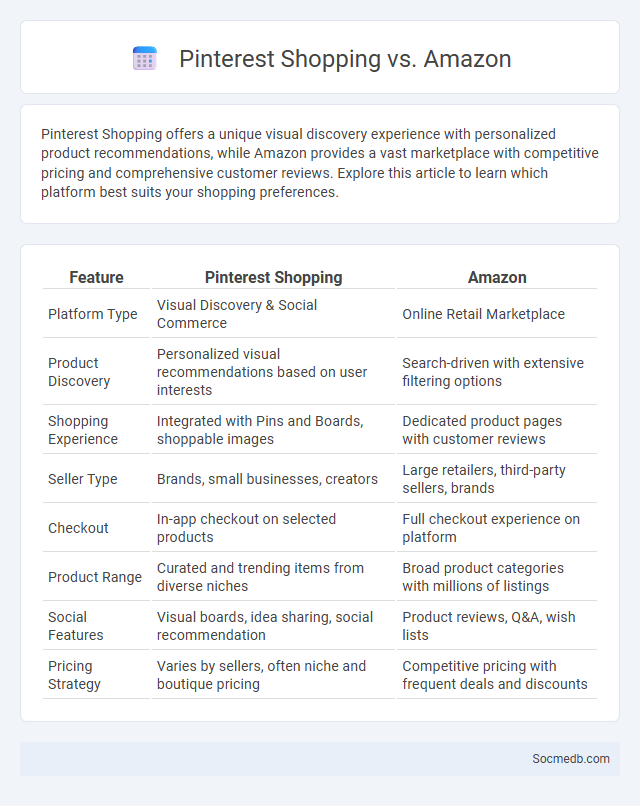
Photo illustration: Pinterest Shopping vs Amazon
Pinterest Shopping offers a unique visual discovery experience with personalized product recommendations, while Amazon provides a vast marketplace with competitive pricing and comprehensive customer reviews. Explore this article to learn which platform best suits your shopping preferences.
Table of Comparison
| Feature | Pinterest Shopping | Amazon |
|---|---|---|
| Platform Type | Visual Discovery & Social Commerce | Online Retail Marketplace |
| Product Discovery | Personalized visual recommendations based on user interests | Search-driven with extensive filtering options |
| Shopping Experience | Integrated with Pins and Boards, shoppable images | Dedicated product pages with customer reviews |
| Seller Type | Brands, small businesses, creators | Large retailers, third-party sellers, brands |
| Checkout | In-app checkout on selected products | Full checkout experience on platform |
| Product Range | Curated and trending items from diverse niches | Broad product categories with millions of listings |
| Social Features | Visual boards, idea sharing, social recommendation | Product reviews, Q&A, wish lists |
| Pricing Strategy | Varies by sellers, often niche and boutique pricing | Competitive pricing with frequent deals and discounts |
Overview of Online Shopping Platforms
Online shopping platforms such as Amazon, eBay, and Alibaba have revolutionized consumer behavior by offering vast product selections, competitive pricing, and user-friendly interfaces. These platforms leverage social media integration for targeted marketing, customer reviews, and real-time engagement, enhancing trust and conversion rates. Mobile commerce growth and AI-driven personalization on platforms like Shopify and Etsy continue to reshape the digital retail landscape.
Key Features Comparison: Pinterest Shopping, Amazon, and Shopping Integration
Pinterest Shopping offers visual discovery with personalized recommendations, enabling You to explore products through curated boards and shoppable pins. Amazon provides extensive product variety, fast shipping, and robust user reviews, focusing on convenience and reliability for seamless purchasing. Shopping integration on platforms like Instagram and Facebook combines social engagement with direct buy buttons, enhancing user interaction and simplifying checkout experiences.
User Interface and Experience
Effective social media platforms prioritize a seamless User Interface (UI) that ensures intuitive navigation, clear visual hierarchy, and responsive design across devices, enhancing overall user experience (UX). By integrating personalized content feeds, easy-to-use interactive elements, and fast-loading features, these platforms keep Your engagement high and reduce friction during browsing. Optimizing UI and UX increases user satisfaction, retention rates, and encourages active participation within social media communities.
Product Discovery and Personalization
Social media platforms leverage advanced algorithms to enhance product discovery by analyzing user behavior, preferences, and interactions, ensuring timely and relevant content delivery. Personalized recommendations increase engagement and drive conversions by presenting products tailored to Your unique interests and past activity. This targeted approach boosts brand visibility and improves the overall shopping experience on social channels.
Pricing Models and Fees
Social media platforms primarily use advertising-based pricing models, charging businesses for impressions, clicks, or conversions to maximize reach and engagement. Subscription fees are less common but are implemented by certain platforms offering premium features or ad-free experiences. Influencer partnerships and content creation can also incur costs based on negotiated rates, impacting overall marketing budgets.
Seller and Brand Opportunities
Social media platforms offer sellers and brands unparalleled opportunities for targeted advertising, allowing precise audience segmentation based on demographics, interests, and behavior. These platforms enable direct engagement with customers through interactive content, fostering brand loyalty and real-time feedback. Leveraging tools like influencer partnerships and analytics, brands can optimize campaigns to boost visibility, conversion rates, and sales performance.
Integrated Checkout and Payment Options
Integrated checkout and payment options on social media platforms streamline the purchasing process by allowing users to complete transactions without leaving the app. Features such as Facebook Shops and Instagram Checkout support multiple payment methods, enabling seamless, secure payments that enhance user experience and boost conversion rates. These tools also provide businesses with valuable data analytics, improving targeted marketing and inventory management strategies.
Marketing and Advertising Tools
Social media platforms provide powerful marketing and advertising tools that enable businesses to target specific audiences with precision. Features such as sponsored posts, advanced analytics, and retargeting campaigns enhance your ability to increase brand visibility and drive conversions effectively. Leveraging these tools allows you to optimize ad spend and measure ROI in real time.
Security and Buyer Protection
Social media platforms must implement robust security measures such as multi-factor authentication and encryption to protect users' personal data and prevent unauthorized access. Buyer protection policies, including secure payment gateways and transparent dispute resolution processes, are essential for safeguarding your transactions against fraud and ensuring trust in online marketplaces. Maintaining vigilance and regularly updating privacy settings enhances your overall safety while engaging in social media commerce.
Which Platform Best Suits Your Shopping Needs?
Choosing the right social media platform for shopping depends on your preferences and product types. Instagram offers highly visual content with shopping features integrated into posts and stories, making it ideal for fashion and beauty products. Pinterest caters to inspiration-driven purchases with its curated boards, while Facebook's Marketplace provides a versatile space for a wide range of goods and local deals tailored to your interests.
 socmedb.com
socmedb.com